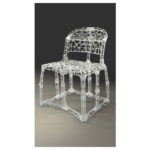A combined project between MIT and ETH Zurich has allowed for the creation of a material with the highest stiffness to weight ratio possible. This means that while the material is very rigid, it also balances this with a relatively low weight. In essence, it is the stiffest material yet and is pretty close to the theoretical limits that physics allows. The research could open up new avenues in the development of anything from medical implants to construction projects.
This sort of stiffness to weight ratio is crucial for planes and race-cars, as one example. To achieve the speeds that they need, they can’t consist of the heaviest forms of their respective metals. Similarly, medical implants shouldn’t weigh down the person using them but they should be rigid enough to withstand significant force.
So, how does one achieve a stiffness without weighing the material down? This particular trick lies in the inner structure. The main idea is not as much in the material in use as it is in the construction on the micro-scale. With the use of intricate patterns of trusses, girdles and arches, the researchers not only maximised stiffness, but also achieved a high strength printout using plastic. Moreover, they achieved a print that measures equally in all 3 directions when it comes to stiffness and strength.
Manufacturing Stiffness
Dirk Mohr, Professor of Computational Modeling of Materials in Manufacturing at ETH Zurich, was one of the researchers experimenting with difference forms to achieve the correct properties to build the stiffest material. “The truss principle is very old; it has long been used for half-timbered houses, steel bridges and steel towers, such as the Eiffel Tower. We can see through truss lattices, so they are often perceived as ideal lightweight structures. However, using computer calculations, theory and experimental measurements, we have now established a new family of plate-lattice structures that are up to three times stiffer than truss-lattices of the same weight and volume.”
The researchers designed the lattice structures using computer models. The initial prints were in micrometer scale for early testing. The researchers are certain that these measurements and properties will hold up at any scale. This gives the material the cross-applicability that makes it useful for medical implants and airplane and car interiors.
“Lightweight construction, the current cost of which limits its practical use to aircraft manufacturing and space applications, could then also be used for a wide array of applications in which weight plays a role,” Mohr said.
Moreover, since the actual trick lies in the inner structure, the research could apply the principles to multiple materials. With the right combination of trusses, arches and girdles they could make many different material the stiffest versions of themselves. Sadly, Mohr believes this breakthrough will have it heyday much later, when 3D printing is a mass production technology. Current construction costs for these lattices make steel “as expensive as silver” per gram. Still, it presents an idea that could really revolutionise a whole host of industries in due time.
Featured image courtesy of ETH Zurich.











